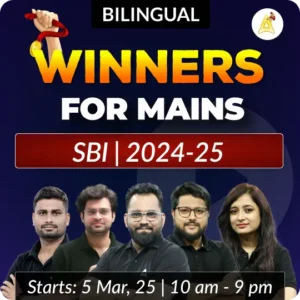Table of Contents
The SBI Clerk Prelims Exam 2025 is an important test for those looking to build a career in the banking sector. It is a highly competitive exam that requires smart preparation and a clear understanding of key topics. The exam will be held on 22 February, 27 February, 28 February, and 1 March 2025, giving aspirants limited time to strengthen their skills. To perform well, candidates must focus on important topics in each section and practice regularly. This article provides important topics for the exam along with effective preparation tips to help you plan your studies and improve your chances of success.
Important Topics for SBI Clerk 2025 Prelims Exam
The SBI Clerk Prelims Exam 2025 is the first step toward a promising career in banking. By studying the important topics listed below and following a well-planned preparation strategy, candidates can improve their chances of passing the exam. Now is the time to intensify your preparation and aim for success, here are the important topics for the SBI Clerk 2025 prelims.
Also Read, SBI Clerk Prelims Result 2025
1. English Language
This section tests your proficiency in English grammar, vocabulary, and comprehension. Key topics include:
- Reading Comprehension: Focus on passages related to the economy, banking, and social issues.
- Cloze Test: Fill in the blanks with appropriate words.
- Error Detection: Identify grammatical errors in sentences.
- Sentence Improvement: Choose the correct option to improve the sentence.
- Para Jumbles: Rearrange sentences to form a coherent paragraph.
- Vocabulary: Synonyms, antonyms, idioms, and phrases.
Also Read, SBI Clerk Score Card 2025
2. Numerical Ability
This section evaluates your mathematical and problem-solving skills. Key topics include:
- Simplification and Approximation: BODMAS rules, percentages, and fractions.
- Number Series: Identify the missing or wrong number in the series.
- Data Interpretation: Tables, bar graphs, pie charts, and line graphs.
- Arithmetic:
- Ratio and Proportion
- Profit and Loss
- Simple and Compound Interest
- Time, Speed, and Distance
- Time and Work
- Mixtures and Alligations
- Quadratic Equations: Solve quadratic equations to find the value of variables.
Also Read, SBI Clerk Cut Off 2025
3. Reasoning Ability
This section assesses your logical and analytical thinking. Key topics include:
- Puzzles and Seating Arrangements: Linear, circular, and floor-based puzzles.
- Syllogisms: Logical reasoning based on statements and conclusions.
- Coding-Decoding: Decode patterns based on given codes.
- Inequalities: Solve questions based on mathematical inequalities.
- Blood Relations: Analyze family trees and relationships.
- Direction Sense: Questions based on directions and distances.
- Alphanumeric Series: Identify patterns in alphanumeric sequences.
SBI Clerk Prelims Exam Analysis 2025, 22nd February 2025 Shift 1
SBI Clerk 2025 Prelims Exam With Questions & Answers
Directions (1-5): Study the following information carefully and answer the given questions:
Ten persons are sitting in two parallel rows containing 5 person each in such a way that there is an equal distance between adjacent persons. In row-1 U, W, X, Y and Z are sitting and all of them are facing South. In row-2 F, G, H, J and K are sitting and all of them are facing North. Therefore, each person sits in a row faces another person of other row.
G sits opposite to the one who sits second to the left of the one who sits third to the right of Y. Only one person sits between G and J. X sits second to the right of Z. J faces neither X nor Z. K sits second to the left of H and he does not sit at any of the extreme ends. F is not an immediate neighbour of K. W faces neither K nor J.
Q1. Who among the following sits opposite to U?
(a) J
(b) K
(c) F
(d) H
(e) None of these
Q2. Who among the following sits second to the right of W?
(a) Z
(b) U
(c) Y
(d) X
(e) None of these
Q3. Four of the following five belong to a group in a certain way, find which of the one does not belong to that group?
(a) X
(b) H
(c) Y
(d) F
(e) U
Q4. How many persons sit between K and F?
(a) None
(b) Two
(c) One
(d) Three
(e) None of these
Q5. What is the position of H with respect to J?
(a) Third to the left
(b) Immediate right
(c) Second to the left
(d) Third to the right
(e) Fourth to the right
Directions (6-10): Study the following information carefully and answer the questions given below:
Eight persons are sitting in a linear row and all of them face in the north direction. All of them have been tested for covid19. Four of them were positive and four were negative. Note: If two persons have same result it means either both of them are positive or both of them are negative. If two persons have different results, then one of them is positive and the other is negative.
Only two persons sit between P and U who was found negative. S sits second to the right of U. R is an immediate neighbor of S. Only two persons sit between R and W who sits at one of the extreme ends of the row. Persons who sit at the extreme end of the row are positive. T sits fourth to the left of V. Both the immediate neighbors of U have same result. Q and S have the same result. S and P have different result.
Q6. Who among the following person sits exactly between Q and S?
(a) R
(b) T
(c) P
(d) U
(e) None of these
Q7. Which of the following pair of persons have the same result?
(a) V-W
(b) T-Q
(c) P-Q
(d) U-R
(e) S-V
Q8. How many persons sit between P and S?
(a) None
(b) One
(c) Two
(d) Three
(e) More than three
Q9. Which of the following statement is true?
(a) R sits immediate left of V
(b) Only one person sits to the left of T
(c) P is found positive
(d) U and W have the same result.
(e) None is true
Q10. Four of the following five are alike in a certain way and hence form a group which one of the following does not belong to that group?
(a) P
(b) T
(c) S
(d) R
(e) W
Direction (11-17): Read the following passage carefully and answer the questions given below it. Certain words are given in bold to help you locate them while answering some of the questions.
Walking into S Saravanan’s ongoing exhibition at Artworld: Sarala’s Art Centre, is like entering a sandstorm; shades of yellow ochre engulf you. In what he considers his ‘Tryst With Forms’, the show is his first one-man exhibit that largely consists of paintings and metal reliefs put together over the last year. At first glance — and even more so on close inspection — his abstract sensibility confounds the viewer. Only by standing afar can one really see the figures — all angular and Picasso-esque — that comprise his works. Dream for instance, is one of the larger works in this show, depicting the full frontal face of a figure, the long eyelashes and circular patterns near the earlobes hinting at a feminine disposition. The figure however, is more of an outline, a contour — skeletal in its inclination and not possessing the weight that is commonly accorded to skin. Be it the kaleidoscopic patterns that permeate the piece or the rendering of the figure in itself , there is a Cubist inclination to break the form — perhaps even reveal what is under.
Yet, there is an insistence, an overpowering urge to touch the surface, like an old wound that demands to be caressed in order to aid memories. Made with texture white — a multipurpose resin medium that aids in the development of textures — on canvas, the piece helps compose a movement, a back and forth, between two sensibilities; that of sight (the figure itself) and touch (the medium). This dance that pushes the viewer to physically engage with the works is mostly experienced with Saravanan’s paintings in the exhibition. Tribal Woman is another piece that depicts the full frontal face of a figure. Made with crumpled rice paper, the painting prompts the viewer to take note of its textural complexity.
The ochres here are however blended with deep browns and rusty reds and emit a fiery glow that emanates from the centre of the woman’s face. “The color yellow ochre is the first thing that you would notice when you visit places that are occupied by tribal folks. “The forests and sand take on such a tone at around four or five in the evening,” he said. The piece’s tactility is further enhanced by the decorative patterns that crowd the background of the otherwise softly contoured figure.
Whether through the forms themselves or through what they exemplify, Saravanan has portrayed generic aspects of tribal life. His paintings Tribals, Love, and Mother and Daughter among others, all delineate figures that are reflected in the metal relief works displayed at the other end of the gallery. Here, religious and mythological figures are given due consideration: Radha, Krishna, Ganesha and Buddha all form part of the artist’s pantheon of tribal deities, in line with the general theme of the show. The works as such, deal more with forms — as they are meant to — rather than content. What would have bolstered Saravanan’s remarkable tryst with forms is an anchoring into specificities of the regions that undoubtedly inspire him.
Q11.Why has the author called walking into S Saravanan’ s ongoing exhibition at Artworld is like entering into a sandstorm?
(a)As the ochres here are blended with deep browns and rusty reds and emit a fiery glow that emanates from the centre of the woman’s face.
(b)Shades of yellow ochre engulf you.
(c)The color yellow ochre is the first thing that you would notice when you visit places that are occupied by tribal folks.
(d)Both (b) and (c)
(e)None of these
Q12. According to the passage, which of the following statements supports the ‘Tactile beauty’ term for the work done by S Saravanan?
(a)The piece’s tactility is further enhanced by the decorative patterns that crowd the background of the otherwise softly contoured figure.
(b)The piece helps compose a movement, a back and forth, between two sensibilities; that of sight and touch. This pushes the viewer to physically engage with the works.
(c) An overpowering urge to touch the surface, like an old wound that demands to be caressed in order to aid memories.
(d)All (a),(b) and (c)
(e)None of these
Q13. According to the passage how S Saravanan’s abstract sensibility confounds the viewer?
(a)The show is his first one-man exhibit that largely consists of paintings and metal reliefs put together over the last year.
(b)The full frontal face of a figure, the long eyelashes and circular patterns near the earlobes hinting at a feminine disposition, one can dream of for instance, is one of the larger works in this show.
(c)Here, religious and mythological figures are given due consideration all form part of the artist’s pantheon of tribal deities, in line with the general theme of the show.
(d)Only by standing afar can one really see the figures — all angular and Picasso-esque — that comprise his works
(e)None of these
Q14.What are the characteristic features of the S Saravanan’s portraits?
(a)They exemplify generic aspects of tribal life.
(b)Religious and mythological figures are given due consideration: Radha, Krishna, Ganesha and Buddha all form part of the artist’s pantheon of tribal deities, in line with the general theme of the show.
(c)Tribal Woman is another piece that depicts the full frontal face of a figure. Made with crumpled rice paper, the painting prompts the viewer to take note of its textural complexity.
(d)Both (a) and (b)
(e)None of these
Q15. What has supported Saravanan’s remarkable love with this tribal art form?
(a) An anchoring into specificities of the regions.
(b) His love for the tribal people.
(c)He is one of the people from the same tribe .
(d)Both (a) and (c)
(e)None of these
Q16. Choose the word which is most similar in meaning to the word ‘Disposition’ printed in bold as used in the passage.
(a)Nature
(b)Distribution
(c)Transfer
(d)Allocation
(e)Disposal
Q17. Choose the word which is most similar in meaning to the given word ‘Emanates’ printed in bold as used in the passage.
(a)Neglect
(b)Halt
(c)Disregard
(d)Ensue
(e)Repress
Direction (18-27): Read the following passage carefully and answer the questions given below it. Certain words are given in bold to help you locate them while answering some of the questions.
Ecological ruin is on a gallop across South Asia, with life and livelihood of nearly a quarter of the world’s population affected. Yet, our polities are able to neither fathom nor address the degradation. The distress is paramount in the northern half of the subcontinent, roping in the swathe from the Brahmaputra basin to the Indus-Ganga plain.
Within each country, with politics dancing to the tune of populist consumerism, nature is without a guardian. The erosion of civility in geopolitics keeps South Asian societies apart when people should be joining hands across borders to save our common ground. Because wildlife, disease vectors, aerosols and river flows do not respect national boundaries, the environmental trends must perforce be discussed at the regional inter-country level. As the largest nation-state of our region, and the biggest polluter whose population is the most vulnerable, India needs to be alert to the dangerous drift. China has been resolutely tackling air pollution and promoting clean energy. But while Beijing’s centralised governance mandates environmentalism-by-decree, the subcontinental realities demand civic participation for sustainability to work. Unfortunately, despite being a vast democracy where people power should be in the driving seat, the Indian state not only neglects its own realm, it does not take the lead on cross-border environmentalism.
Thus, Bihar is helping destroy the Chure/Siwalik range of Nepal to feed the construction industry’s demand for boulders and conglomerate, even though this hurts Bihar itself through greater floods, desertification and aquifer depletion. Air pollution is strangling the denizens of Lahore, New Delhi, Kathmandu and Dhaka alike, but there is no collaboration. Wildlife corridors across States, provinces and countries are becoming constricted by the day, but we look the other way. The UN Environment Programme (UNEP) has chosen India to be the ‘host country’ to mark World Environment Day today. But when will New Delhi rise to connect the dots between representative democracy and ecological sanity?
Truth be told, the environment ministry is invariably the least empowered in the major countries of South Asia, without clout vis-à-vis line ministries, and unable to coordinate the ecological response. Governments were content once to regard environmental protection as synonymous with wildlife protection. Today they stand unprepared when the challenges have greatly multiplied and deepened. There is distress across the ecological spectrum, but one need only study the rivers and the atmosphere to track the inaction of governments and our weakened activism. On water, the subcontinent is running out of the resource due to the demands of industrialisation and urbanisation, and continuation of the colonial-era irrigation model based on flooding the fields. The economic and demographic forces are arrayed against the rivers and their right-of-way. In the hills, the Ganga in Uttarakhand and the Teesta of Sikkim are representative of rivers that have been converted into dry boulder tracts by ‘cascades’ of run-of-river hydroelectric schemes. The same fate now threatens the rivers of Nepal and India’s Northeast, while the tributaries of the Indus were ‘done in’ decades ago through water diversion.
Everywhere, natural drainage is destroyed by highways and railway tracks elevated above the flood line, and bunds encircling towns and cities. Reduced flows and urban/industrial effluents have converted our great rivers into sewers. We refuse to consider drip irrigation as a solution just as we fail to acknowledge that the rivers are made to carry hundreds of tonnes of plastics daily into the Bay of Bengal and the Arabian Sea. While underground aquifers are exploited to exhaustion, the popular ‘river-training’ prescription imprisons our rivers within embankments, according to the inherited Western engineering canon that does not factor in the natural silt carried by rivers of the Himalaya. The would-be high-dam builders have not adequately studied the phenomenon of Himalayan cloudbursts, nor do they find it necessary to address the question: how do you de-silt a deep reservoir when it fills up with sand and mud?
As we have seen, the highs of environmental movements are invariably followed by lows, and so to exit the cycle what is needed is an “environmental system” inbuilt into the infrastructure of state and society. Work towards ecological sustainability must go beyond ritual, with the path seeming to lie in the empowerment of local government all over. Elected representatives in cities and districts must be challenged to emerge as the bulwark of environmentalism even as the provincial and national governments are asked to rise to their regulatory responsibilities. When ‘organic environmentalism’ rises from the grassroots and makes state authority accountable, South Asia and its peoples will be protected. At that point, no force will be able to stop activism across the frontiers and South Asia will begin to tackle pollution and dislocation as one.
Q18. According to the passage, what is the drawback of the popular ‘river-training’ prescription under inherited Western engineering canon?
(a)It doesn’t consider how to de-silt a deep reservoir when it fills up with sand and mud
(b)How to save natural drainage by highways and railway tracks elevated above the flood line
(c)It does not factor in the natural silt carried by rivers of the Himalaya.
(d)Both (b) and (c)
(e)None of these
Q19.Why author finds the government responsible for the paced ecological imbalance and destruction?
(a)Government in each country is following the populist consumerism theory
(b)Government in countries are neither addressing the issue nor they are getting it.
(c)Government in countries are not taking the lead on cross-border environmentalism.
(d)All of the above
(e)None of these
Q20. According to the passage why South Asian societies are unable to discuss the environmental trends at the regional inter-country level?
(a)As polities are able to neither fathom nor address the degradation
(b)As formal politeness and courtesy in behavior or speech has totally vanished in geopolitics
(c)Today they stand unprepared when the challenges have greatly multiplied and deepened
(d)Both (a) and (c)
(e)None of these
Q21. Which of the following options explain the most suitable meaning of the phrasal verb ‘done in’ used?
(a)To make something happen
(b)Extremely tired
(c)Be unwilling to tolerate or be bothered with
(d)In a situation so bad that it is impossible to get out
(e)None of these
Q22.What are the reasons that the subcontinent is running out of the water resources?
(a)Industrialization and urbanization
(b)Continuation of the old irrigation model based on flooding the fields
(c)By continuous use of run-of-river hydroelectric schemes
(d)Natural drainages are being destroyed by highways and railway tracks elevated above the flood line (e)All of the above
Directions (23-25): Choose the word which is most similar in meaning to the word printed in bold as used in the passage.
Q23. Gallop
(a)Amble
(b)Stroll
(c)Crawl
(d)Hasten
(e)Lumber
Q24. Fathom
(a)Misinterpret
(b)Misunderstand
(c)Neglect
(d)Guess
(e)Understand
Q25.Perforce
(a)Inevitably
(b)Unnecessarily
(c)Subliminally
(d)Equivocally
(e)None of these
Directions (26-27): Choose the word which is most opposite in meaning to the word printed in bold as used in the passage.
Q26. Denizens
(a)Inhabitant
(b)Resident
(c)Alien
(d)Townsman
(e)Native
Q27. Fate
(a)Influence
(b)Misfortune
(c)Chance
(d)Destiny
(e)Consequence
Directions (28-30): Read each sentence to find out whether there is any grammatical or idiomatic error in it. The error, if any, will be in one part of the sentence. The number of that part is the answer. If there is ‘No error’, the answer is (e). (Ignore errors of punctuation, if any.)
Q28. When I receive (a)/ the letter, the date (b)/ for the interview (c)/ was already over. (d)/ No error. (e)
Q29. We had (a)/ helped him (b)/ if he had (c)/ requested us earlier. (d)/ No error. (e)
Q30. We have observed that (a)/ many good programmes (b)/ suffer of shortage (c)/ of funds and other resources. (d)/ No error. (e)
Q31. B’s capital is 35 times more than A’s capital. B invested his capital at 25% per annum for two years on compound interest. At what rate of interest per annum on simple interest should A invest his capital so that after two years, they both will be received same amount.
(a) 25%
(b) 35%
(c) 55%
(d) 65%
(e) 75%
Q32. A boat covers 120 km downstream in 8 hours and the same distance covers in upstream in 40 hours. If the speed of boat in still water and speed of stream is increased by 6 kmph and 4 kmph respectively, then what is the total time (in hours) taken by the boat to covers 200 km in upstream and downstream each?
(a) 50
(b) 48
(c) 42
(d) 44
(e) 46
Q33. A bag contains (x+4) pink, 6 green and 8 brown colour balls. If two balls are taken randomly and the probability of getting both are green colour balls is 592, then find the difference between the number of pink colour balls and the number of brown colour balls.
(a) 3
(b) 2
(c) 4
(d) 1
(e) 5
Q34. P, Q, R and S are four pipes which can either fill or empty a tank in 12 hours, 20 hours, 30 hours and 15 hours respectively. If the whole tank is filled in 15 hours when all the pipes are working together, then find the maximum possible number of outlet pipes.
(a) 0
(b) 1
(c) 2
(d) 3
(e) Can’t be determined
Q35. The cost price (CP) of article A is 25% more than the cost price of article B and the ratio of the marked price (MP) of article A to that of article B is 12:5. If the shopkeeper offers a discount of x% and (x + 5) % on marked price of article B and article A respectively while he gets the profit of 25% on article B and 20% on article A, then find the value of x?
(a) 90
(b) 80
(c) 70
(d) 60
(e) 50
Q36. Sanjay starts a business with an investment of Rs.24000. After six months, Robin also joins him with an investment of Rs. 36000. At the end of two years, the difference between their profit share is Rs.7500. If Ankur has half of the profit share of Sanjay and he invested it on simple interest at 8% p.a. for five years, then find amount received by Ankur after 5 years.
(a) Rs.48000
(b) Rs.72000
(c) Rs.60000
(d) Rs.42000
(e) Rs.84000
Q37. A vessel contains mixture of milk and water in the ratio 2:1 respectively. x liters of milk is removed out and 2x liters of water is added into the remaining mixture. The ratio of milk to water in the resultant mixture become 6:5. If the resultant quantity of mixture become 99 liters, then find the quantity of water is added?
(a) 14.4 kg
(b) 11 kg
(c) 9.8 kg
(d) 15 kg
(e) 17.2 kg
Q38. Length of a rectangular field is 200% of radius of a circular field whose circumference is 264 meters. If area of the rectangular field is 2016 m2, then find radius of circular field is what percent more than breadth of the rectangular field?
(a) 75%
(b) 125%
(c) 50%
(d) 25%
(e) 87.5%
Q39. Ten years hence, the ratio of the ages of Bhola and Ram will be 9:5 respectively. If Ram is 10 years younger to Bhola, then find the present age Ram is what % present age of Bhola?
(a) 25%
(b) 40%
(c) 10%
(d) 15%
(e) 20%
Q40. The annual income of Kamal is Rs.228000. He spends 30% of his monthly income on rent and 25% of the remaining monthly income on food and saves rest of the amount. Find the monthly saving of Kamal (in Rs.).
(a) Rs. 9975
(b) Rs. 10033
(c) Rs. 8756
(d) Rs. 11267
(e) Rs. 7777
Directions (41-46): The line chart given below shows total number of items delivered by five different (P, Q, R, S and T) delivery men and table shows the percentage of items which were rejected by customers out of total items delivered by respective delivery men.
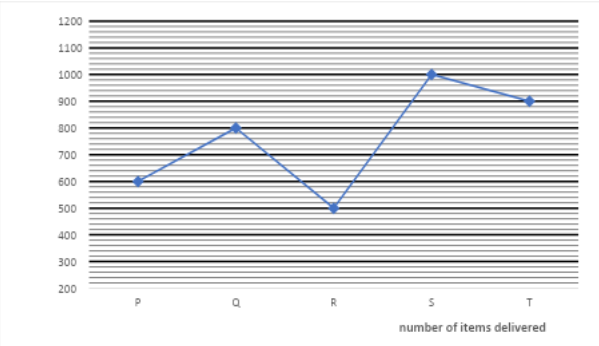
| Delivery men | Percentage of items rejected |
| P | 20 |
| Q | 25 |
| R | 10 |
| S | 40 |
| T | 30 |
Note – Number of items delivered = items rejected + items not rejected by customer.
Q41. If ‘A’ be 50 less than average number of items which were rejected by the customers to delivery man P, R and S together, then find A.
(a) 140
(b) 180
(c) 100
(d) None of these
(e) 160
Q42. Find the number of items delivered by delivery man S which are not rejected are what percent more or less than total items which are rejected by customers from delivery man Q and R together?
(a) 110% less
(b) 125% more
(c) 125% less
(d) 140% more
(e) 140% less
Q43. Find the ratio of number of items which are rejected by customers from delivery man S and Q together to total number of items which are not rejected by customers from delivery man T?
(a) 12 : 11
(b) 11 : 12
(c) 20 : 21
(d) 21 : 20
(e) None of these
Q44. Find the average number of rejected items by the customer from all the five delivery men.
(a) 218
(b) 208
(c) 232
(d)192
(e)184
Q45. Find the sum of number of items which are delivered by delivery man P and T are how much more or less than the square of 39.
(a) None of these
(b) 33
(c) 11
(d) 28
(e) 21
Direction (46-50): Table given below shows total number of people (Male & female) visited four different malls (A, B, C and D) on Monday. The table also shows total number of males visited these malls. Read the data carefully and answer the questions.
| Malls | Total number of people | Total number of males |
| A | 200 | 4X |
| B | 120 | 4Y |
| C | 180 | 5Y |
| D | 200 | 3X |
Note: Total number of males visited in A and C is 220 and the total number of males visited B and D is 170.
Q46. Find the ratio of the number of females visited mall C and A together to the number of females visited mall B and D together.
(a) 18: 19
(b) 15: 11
(c) 16: 15
(d) 12: 17
(e) None of these
Q47. Find the number of people visited mall A and D together is what percentage more/less than the number of people visited mall B and C together.
(a) 10%
(b) 20%
(c) 6%
(d) 33.33%
(e) 4%
Q48. Each female who visited mall B on Monday did the shopping of Rs. 2000 and each male who visited the mall B on Monday did the shopping of Rs. 1500, the find the total amount spent by all the people who visited mall B on Monday.
(a) Rs. 205000
(b) Rs. 203000
(c) Rs. 202000
(d) Rs. 252000
(e) Rs. 200000
Q49. Number of people visited mall A on Tuesday is 20% more than that of people visited mall C on Monday. If the ratio of number of females visited mall B on Monday to that of females visited mall A on Tuesday is 2: 3, then find the how many numbers of males increase/decrease in the mall A on Tuesday with respect to Monday.
(a) 36
(b) 44
(c) 28
(d) 40
(e) 45
Q50. In mall E, Number of people visited on Monday is 10% less than that of people visited A and C together on Monday. If the number of males visited mall E is half of the number of males visited B and C together on Monday, then find the number of females visited mall E.
(a) 166
(b) 160
(c) 252
(d) 155
(e) 154
Solutions:
Solutions (1-5):
Sol.
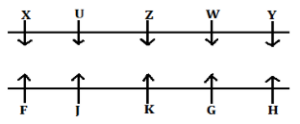
S1. Ans. (a)
S2. Ans. (b)
S3. Ans. (e)
S4. Ans. (c)
S5. Ans. (d)
Solutions (6-10):
Sol.

S6. Ans. (d)
S7. Ans. (e)
S8. Ans. (e)
S9. Ans. (c)
S10. Ans. (c)
S11. Ans. (b)
Sol. Option (b) is the correct answer choice. Option (b) can be traced from the very line of the 1st paragraph of passage where it is stated as “Walking into S Saravanan’s ongoing exhibition at Artworld: Sarala’s Art Centre, is like entering a sandstorm; shades of yellow ochre engulf you.”
S12. Ans. (d)
Sol. Option (d) is the correct answer choice.
Tactile- of or connected with the sense of touch.
Option (a) and (b) can be traced from the 2nd paragraph of passage where it is stated as “Yet, there is an insistence, an overpowering urge to touch the surface, like an old wound that demands to be caressed in order to aid memories. Made with texture white — a multipurpose resin medium that aids in the development of textures — on canvas, the piece helps compose a movement, a back and forth, between two sensibilities; that of sight (the figure itself) and touch (the medium). This dance that pushes the viewer to physically engage with the works is mostly experienced with Saravanan’s paintings in the exhibition.” Option (c) can be traced from the last lines of the 2nd paragraph ““The forests and sand take on such a tone at around four or five in the evening,” he said. The piece’s tactility is further enhanced by the decorative patterns that crowd the background of the otherwise softly contoured figure.”
S13. Ans. (b)
Sol. Option (b) is the correct answer choice. Option (b) can be traced from the 1st paragraph of passage where it is stated as “Only by standing afar can one really see the figures — all angular and Picasso-esque — that comprise his works. Dream for instance, is one of the larger works in this show, depicting the full frontal face of a figure, the long eyelashes and circular patterns near the earlobes hinting at a feminine disposition.”
S14. Ans. (d)
Sol. Option (d) is the correct answer choice. Option (a) and Option (b) can be traced from the last paragraph of passage where it is stated as “Whether through the forms themselves or through what they exemplify, Saravanan has portrayed generic aspects of tribal life. His paintings Tribals, Love, and Mother and Daughter among others, all delineate figures that are reflected in the metal relief works displayed at the other end of the gallery. Here, religious and mythological figures are given due consideration: Radha, Krishna, Ganesha and Buddha all form part of the artist’s pantheon of tribal deities, in line with the general theme of the show.”
S15. Ans. (a)
Sol. Option (a) is the correct answer choice. Option (a) can be traced from the last paragraph of passage where it is stated as “What would have bolstered Saravanan’s remarkable tryst with forms is an anchoring into specificities of the regions that undoubtedly inspire him.”
S16. Ans. (a)
Sol. Option (a) is the correct answer choice.
Disposition- a person’s inherent qualities of mind and character
All the other given options are synonyms of the given word but in context of the law. So the suitable answer choice is option (a).
S17. Ans. (d)
Sol. Option (d) is the correct answer choice.
Emanates- (of a feeling, quality, or sensation) issue or spread out from (a source)
Ensue- happen or occur afterwards or as a result.
Halt-bring or come to an abrupt stop.
Repress- subdue (someone or something) by force.
S18. Ans. (c)
Sol. Option (c) is the correct answer choice. Option (c) can be traced from the 5th paragraph of passage where it is stated as “While underground aquifers are exploited to exhaustion, the popular ‘river-training’ prescription imprisons our rivers within embankments, according to the inherited Western engineering canon that does not factor in the natural silt carried by rivers of the Himalaya.”
S19. Ans. (d)
Sol. Option (d) is the correct answer choice. Option (b) can be traced from the 1st paragraph of passage where it is stated as “Ecological ruin is on a gallop across South Asia, with life and livelihood of nearly a quarter of the world’s population affected. Yet, our polities are able to neither fathom nor address the degradation.” Option (a) is stated in the first line of 2nd paragraph “Within each country, with politics dancing to the tune of populist consumerism, nature is without a guardian.” Option (c) can be traced from the last line of the 2nd paragraph where it is stated as “Unfortunately, despite being a vast democracy where people power should be in the driving seat, the Indian state not only neglects its own realm, it does not take the lead on cross-border environmentalism.”
S20. Ans. (b)
Sol. Option (b) is the correct answer choice. Option (b) can be traced from the 2nd paragraph of passage where it is stated as “The erosion of civility in geopolitics keeps South Asian societies apart when people should be joining hands across borders to save our common ground.”
S21. Ans. (b)
Sol. option (b) is the most suitable answer choice.
‘Done in’- extremely tired.
S22. Ans. (e)
Sol. option (e) is the most suitable answer choice as all the given statements are true. Option (a), (b) and (c) can be traced from the 4th paragraph where it is given as “On water, the subcontinent is running out of the resource due to the demands of industrialization and urbanization, and continuation of the colonial-era irrigation model based on flooding the fields. The economic and d
emographic forces are arrayed against the rivers and their right-of-way. In the hills, the Ganga in Uttarakhand and the Teesta of Sikkim are representative of rivers that have been converted into dry boulder tracts by ‘cascades’ of run-of-river hydroelectric schemes.” Option (d) can be traced from the 5th paragraph where it is given as “Everywhere, natural drainage is destroyed by highways and railway tracks elevated above the flood line, and bunds encircling towns and cities. Reduced flows and urban/industrial effluents have converted our great rivers into sewers.”
S23. Ans. (d)
Sol. Option (d) is the best answer choice here.
Gallop- a very fast pace of running
All the given options are the antonyms of the given word ‘gallop’ except option (d)
S24. Ans. (e)
Sol. Option (e) is the best answer choice here.
Fathom-understand (a difficult problem or an enigmatic person) after much thought
All the given options are different in meaning except ‘understand’
S25. Ans. (a)
Sol. Perforce- used to express necessity or inevitability.
Subliminally- below the threshold of sensation or consciousness
Equivocally- in a deliberately ambiguous or questionable way
Option (a) is the best answer choice here.
S26. Ans. (c)
Sol. Denizens- a person, animal, or plant that lives or is found in a particular place
All the given options are the synonyms of the given word ‘denizen’ except option (c), ‘alien’
S27. Ans. (b)
Sol. Fate- the development of events outside a person’s control, regarded as predetermined by a supernatural power.
All the given options are either the synonyms or altogether different in meaning to the given word ‘fate’, except option (b).
S28. Ans. (a)
Sol. ‘received’ will be used in place of ‘receive’ as the sentence is in past tense as is indicated by ‘already over’.
S29. Ans. (a)
Sol. ‘we would have’ will be used in place of ‘we had’ as for unreal situation of past ‘Subject + would/ could/ might/ should + have + V3’ is used.
Ex. I would have helped you if you had come earlier.
S30. Ans. (c)
Sol. ‘from’ will be used in place of ‘of’ as preposition ‘from’ is used after ‘suffer’.
Ex. He is suffering from fever.
S31. Ans (e)
Sol.
Let the required rate of interest be R% p.a.
Let the A’s and B’s capital be 5x and 8x respectively
Equivalent rate of compound interest at 25% p.a. for 2 years = (25+25+25×25100)%=56.25%
ATQ,
5x(100+2R100)=156.25100 (8x)
100 + 2R = 156.25×8x5x
100 + 2R = 250
2R = 150
R = 75%
S32. Ans (b)
Sol.
Speed of boat in downstream =1208 = 15 kmph
Speed of boat in upstream = 12040 = 3 kmph
Speed of the boat in still water =15 + 32 = 9 kmph
Speed of the stream = 15-32 = 6 kmph
New speed of boat in still water = 9 + 6 = 15 kmph
New speed of stream = 6 + 4 = 10 kmph
Downstream speed = 15+ 10 = 25 kmph
Upstream speed=15 – 10=5 kmph
Required time=20025 +2005 = 8 + 40 = 48 hours
S33. Ans (b)
Sol.
ATQ, 6x+185x+17=592
552 = x2 +35x +306
x2 +35x -246 = 0
x2 +41x -6x -246 = 0
x (x+41) -6 (x+41) = 0
(x-6) (x+41) = 0
x = 6, -41
x = -41 (not possible)
x = 6
Required difference = (6+4)-8 = 2
S34. Ans (c)
Sol.
Let the capacity of the tank be 60 units. (LCM of 12, 20, 30 and 15)
Efficiency of P= 6012=5 units/hour
Efficiency of Q= 6020=3 units/hour
Efficiency of R= 6030=2 units/hour
Efficiency of S= 6015=4 units/hour
If the tank is filled in 15 hours when all the pipes are working together, then efficiency should be 6015=4 units/hour
Case I– Q, R, S are inlet pipes and P is outlet pipe. (3+2+4 – 5 = 4 units/hour)
Outlet pipe = 1
Case II- P&S are inlet pipes and Q &R are outlet pipes. (5+4 – 3 –2 = 4 units/hour)
Outlet pipe = 2
So, the maximum possible number of outlet pipes= 2
S35. Ans (a)
Sol.
Let CP of article B = 4y
CP of article A =125100× 4y = 5y
Selling price (SP) of article B = 4y×125100=5y
Selling price of article, A = 5y×120100=6y
Let MP of article B = 5z & MP of article A = 12z
5y = 5z(100-x100)
y =z100 – x100……………….(i)
6y= 12z100 – x + 5100
y = 2z (100 – x + 5100)………..(ii)
Equating (i) & (ii)
z100 – x100 = 2z100 – x + 5100
100 – x = 2(100 – x – 5 )
100- x= 200 – 2x – 10
x = 190-100
x = 90
S36. Ans. (d)
Sol.
Ratio of profit share of Sanjay and Robin=
=24000×24:36000×18
=8:9
So, profit share of Sanjay =89-8×7500 =Rs.60000
Required amount = 60000/2+ 60000/2 x 40100 = 42000 Rs.
S37. Ans(a)
Sol.
Quantity of milk is taken out = x liters
Quantity of water is added =2x liters
Final quantity of milk and water in vessel =99×6/11=54 liters and 99×5/11=45 liters respectively
ATQ, 54+x/45-2x=21
x=7.2
Quantity of milk added = 7.2×2=14.4 liters
S38. Ans(a)
Sol.
Let radius of circular field be ‘r’
ATQ –
2 ×π×r=264
r = 264 ×72/22×2 = 42 meters
Length of rectangular field = 42 ×2=84 meters
Let breadth of rectangular field be ‘b’
84 ×b = 2016
b = 24 meters
Required percentage = 42-24/24 ×100=75%
S39. Ans (e)
Sol.
Let the present age of Bhola and Ram be x+10 years and x years respectively.
ATQ.
x+10+10/x+10=95
5x+20=9x+10
4x=10
x=2.5 years
Required percentage = 2.5/12.5×100=20%
S40. Ans (a)
Sol.
Monthly income of Kamal = 228000/12=Rs.19000
Amount spend on rent = 19000×30/100=Rs.5700
Amount spend on food = 19000-5700=13300
13300×25/100=Rs 3325
Monthly saving of Kamal = 19000-5700-3325=Rs.9975
Sol. (41-46):
For Delivery man P:
Total items delivered=600
Total rejected items=600×20100=120
Total non-rejected items=600-120=480
Similarly for other delivery men,
| Delivery man | Total items | Rejected items | Non-rejected items |
| P | 600 | 120 | 480 |
| Q | 800 | 200 | 600 |
| R | 500 | 50 | 450 |
| S | 1000 | 400 | 600 |
| T | 900 | 270 | 630 |
S41. Ans.(a)
Sol.
Average number of rejected items to P, R and S
=120+50+4003=190
Required value, A=190-50=140
S42. Ans.(d)
Sol.
Items which are not rejected by customer to delivery man S = 600
Items which were rejected by costumer to delivery man Q and R together
=250
Required Percentage =600-250250×100=140%
S43. Ans.(c)
Sol.
Required ratio =400+200:630=20:21
S44. Ans.(b)
Sol.
Required average=120+200+50+400+2705
=10405=208
S45. Ans.(e)
Sol.
Sum of number of items delivered by delivery man P and T
=600+900=1500
Required value=1521-1500=21
Sol. (46-50):
ATQ, 4X + 5Y= 220…….(1)
3X + 4Y = 170 …….(2)
Solving (1) and (2)
Y = 20
X = 170-803=30
Now,
| Malls | Total number of people | Number of Males | Number of females |
| A | 200 | 120 | 80 |
| B | 120 | 80 | 40 |
| C | 180 | 100 | 80 |
| D | 200 | 90 | 110 |
S46. Ans. (c)
Sol. Required ratio = 160150=16:15
S47. Ans. (d)
Sol. Required percentage = 400-300300×100%=3313%
S48. Ans. (e)
Sol. Amount spent by females who visited mall B = 40×2000=Rs. 80000
Amount spent by males who visited mall B = 1500×80 = Rs. 120000
Required sum = 120000 + 80000 = Rs. 200000
S49. Ans. (a)
Sol. Number of people visited mall A on Tuesday = 65×180=216
Number of females visited mall A on Tuesday = 32×40=60
Number of males visited mall A on Tuesday = 216-60=156
Required difference = 156 – 120 = 36
S50. Ans. (c)
Sol. Number of people visited mall E = 910×(380)=342
Number of males visited mall E = 1802 = 90
Number of females visited mall E = 342 – 90 = 252
Preparation Tips for SBI Clerk Prelims 2025
- Understand the Syllabus: Focus on high-weightage topics and allocate time accordingly.
- Create a Study Plan: Dedicate daily time slots for each section and stick to the schedule.
- Practice Mock Tests: Take online mock tests to simulate the exam environment and improve time management.
- Revise Regularly: Make short notes for quick revision of formulas, vocabulary, and shortcuts.
- Analyze Previous Year Papers: Identify recurring topics and question patterns.
| Related Posts | |
| SBI Clerk Mains Exam Date 2025 | SBI Clerk Preparation |
| SBI Clerk Cut Off | SBI Clerk Syllabus |
| SBI Clerk Salary | SBI Clerk Previous Year Question Paper |
| SBI Clerk Mock Test |
|

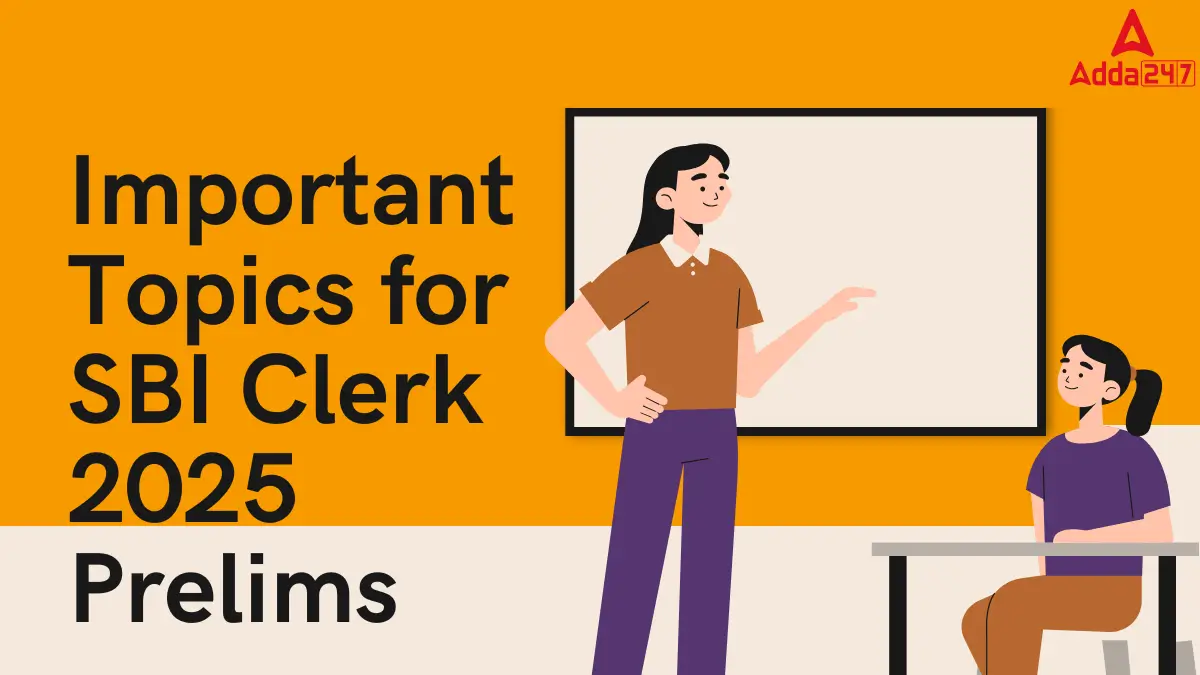


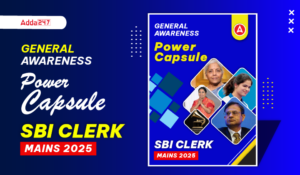 GA Capsule for SBI Clerk Mains 2025, Dow...
GA Capsule for SBI Clerk Mains 2025, Dow...
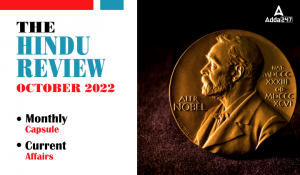 The Hindu Review October 2022: Download ...
The Hindu Review October 2022: Download ...
 Books and Authors Capsule for SBI PO Mai...
Books and Authors Capsule for SBI PO Mai...

